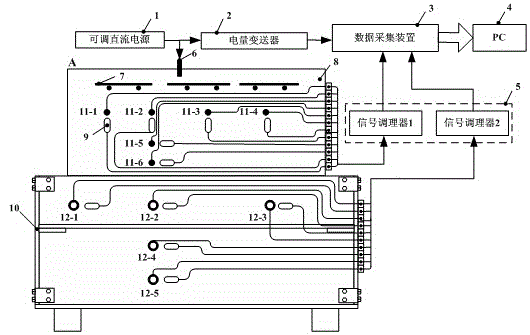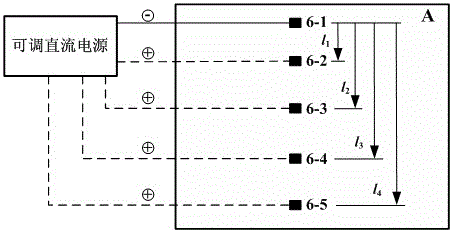Experiment system for corrosion of stray currents in subway
A technique for stray current and corrosion experiments, applied in weather resistance/light resistance/corrosion resistance, measuring devices, instruments, etc., can solve problems such as inability to quantitatively express the relationship between polarization potentials
- Summary
- Abstract
- Description
- Claims
- Application Information
AI Technical Summary
Problems solved by technology
Method used
Image
Examples
Embodiment 1
[0018] Example 1: The subway stray current corrosion experiment system includes: an adjustable DC power supply 1, a power transmitter 2, a data acquisition device 3, a host computer 4, a signal conditioner 5, an auxiliary electrode 6, a steel mesh 7, and a reinforced concrete block 8. Reference electrode 9, soil tank 10, steel bar 11 and steel pipe 12. The positive and negative electrodes of the adjustable DC power supply 1 are respectively connected to two different auxiliary electrodes 6, and the auxiliary electrodes 6 are embedded in the upper surface of the reinforced concrete block 8; the reinforcing bars 11 are distributed at different positions inside the reinforced concrete block 8, and six are arranged in total; The lower surface of the concrete block 8 is in close contact with the soil medium in the soil box 10, and five steel pipes 12 with different positions are arranged in the soil box 10; the reference electrode 9 is buried next to the steel bar 11 and the steel p...
PUM
| Property | Measurement | Unit |
|---|---|---|
| Size | aaaaa | aaaaa |
| Size | aaaaa | aaaaa |
Abstract
Description
Claims
Application Information
 Login to View More
Login to View More - R&D
- Intellectual Property
- Life Sciences
- Materials
- Tech Scout
- Unparalleled Data Quality
- Higher Quality Content
- 60% Fewer Hallucinations
Browse by: Latest US Patents, China's latest patents, Technical Efficacy Thesaurus, Application Domain, Technology Topic, Popular Technical Reports.
© 2025 PatSnap. All rights reserved.Legal|Privacy policy|Modern Slavery Act Transparency Statement|Sitemap|About US| Contact US: help@patsnap.com


